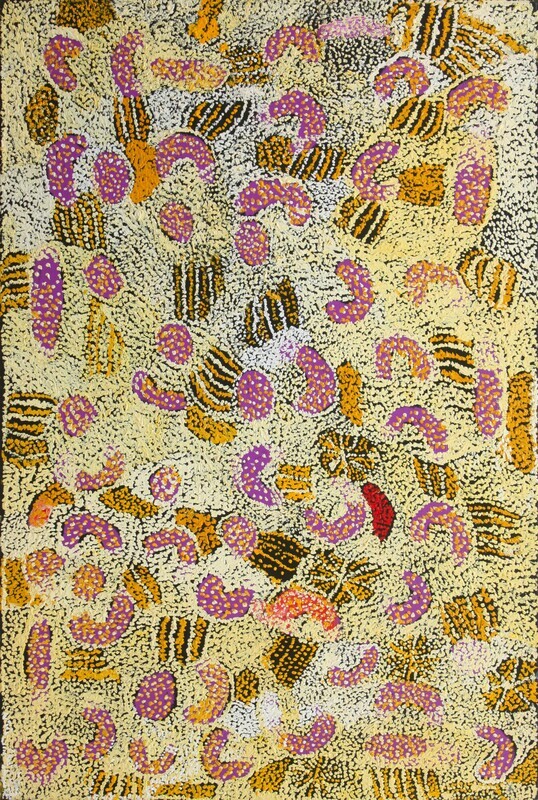Elizabeth Nyumi Nungurrayi
Elizabeth Nyumi Nungurrayi
- Born: c. 1945
- Died: 2019
- Skin: Nungurrayi
- Language: Pintupi
- Location: Parwalla
Biography
Elizabeth Nyumi Nungurrayi was born around 1945 near Jupiter Well, located on the Gary Junction Road, 146 kilometers west of Kiwirrkurra and 210 kilometers east of the Canning Stock Route. She spoke Pintupi and began painting with Warlayirti Artists in 1988.
Elizabeth lived a nomadic life in her early years with her family group on the Canning Stock Route before walking into the Old Mission with her father after her mother died tragically from a dingo bite. At the mission, she was trained as a house worker, performing tasks like cleaning, washing dishes, and raking the grounds. Elizabeth married Palmer Gordon, a senior lawman of the Billiluna community, and together they taught traditional culture to the children, ensuring the preservation of traditional dances and songs. She also advised nursing staff at the health clinic about traditional bush medicines and was knowledgeable about carving coolamons and digging sticks.
Elizabeth's paintings primarily focus on the country rich with bush food belonging to her family. Initially, she worked with a thick brush, covering the canvas with emanating lines in muted tones. Her style evolved to using a multitude of dots to build up fields of texture, while maintaining her signature motifs of small camps, coolamons, and bush tucker trees and shrubs.
Themes
- Pawalla: Her country and its abundant bush foods
- Purra: Bush tomato
- Rockholes and soaks
- Coolamons and digging sticks
- Kantilli: Bush raisin
- Minyali: Seed
- Nynmi (Jupiter Well): The Tjukurrpa story of the old woman who killed and ate a snake with her two children
- Tingari
Exhibitions
- 2007: Group Exhibitions at various locations in Beijing, P.R. China (June, July, August, November)
- 2007: Elizabeth Marks Nakamarra: New Beginnings , Vivien Anderson Gallery, Melbourne
- 2004: Gallery Pizzi, Melbourne
- 2003: Glen Eira City Gallery, Melbourne
- 2002-03: Chapel of Chapel Gallery, Melbourne
- 2001-02: Victorian Artists Society Galleries, Melbourne
Collections
- Museums and Art Galleries of the Northern Territory
- Artbank
- The Kerry Stokes Collection
- Mem Aziz Collection
- The Nahum Collection, London
Artistic Style and Evolution
Elizabeth began painting in 1987 and emerged as a leading artist in the late 1990s. Initially using thick brushes to create fluid lines, she transitioned to dotting techniques, creating textured fields. Her later works became more spacious and minimal, with a restricted palette dominated by yellow and white. Her style, marked by a kinetic optical effect created through layered alternating colors, pays homage to the aesthetic tradition of body painting. Elizabeth's work has been widely acclaimed, with her inclusion in the 2004 Biennale of Sydney and numerous solo exhibitions in Darwin, Sydney, and Melbourne.
Legacy
Elizabeth Nyumi is regarded as the foremost of the second-generation Balgo artists, significantly contributing to the success of the Warlayirti Art Centre at Balgo Hills. Her distinct and individual depictions of country have extended the reputation of Balgo women artists.
Bibliography
- Alexander, G. (2004). Balgo 4-04 . Vega Press, Melbourne.
- Mahood, K. (2005). ‘Under the Skin,’ Artlink. Vol 25. No. 2: 14-18.
- O’Brien, P. (2004). ‘Sacred food: Elizabeth Nyumi.’ Artlink, v.24, no.1: 64-65
- Williamson, S., & Togni, S. (2004). ‘Abundance, the art of Elizabeth Nyumi.’ Art and Australia, v.41, no.4: (574)-579
4o

